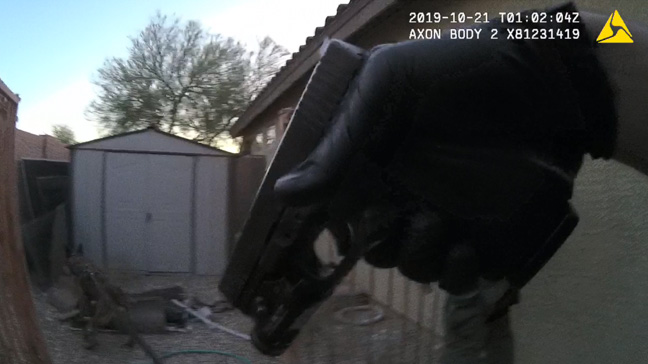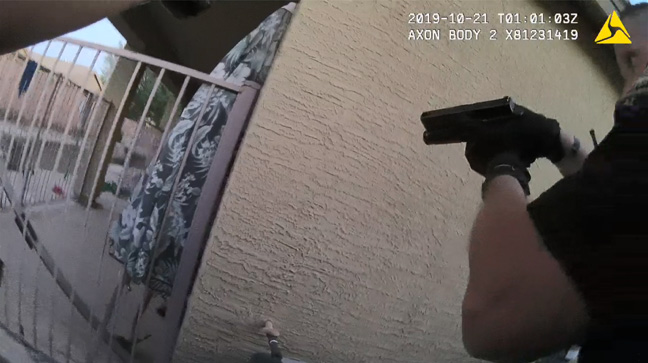Police Brutality Involving the Use of a Firearm

When a police officer shoots someone, it is considered deadly force. It is no surprise that lawsuits seeking significant damages are often filed after an officer discharges a firearm. However, even pointing a gun at a person can violate their constitutional rights. There are strict limitations on when the police are allowed to shoot or point a gun at someone. Both of these uses of a firearm are discussed below.
When Does Shooting Someone Amount to Excessive Force?
When analyzing the lawfulness of a police officer’s use of deadly force, courts begin with two important United States Supreme Court cases from the 1980s. These are Tennessee v. Garner and Graham v. Connor. In Tennessee v. Garner, the Court set strict limits on when the cops are allowed to shoot a suspected felon. The requirements are:
- It must be necessary to prevent the suspected felon’s escape; and
- The police officer must have probable cause to believe the fleeing felon presents an immediate risk of serious harm or death to others.
The Court also suggested that a warning should be given, if feasible, before firing. It is important to note that if a once-dangerous suspect is no longer a threat of harm to others, deadly force may not be used. Recently, the Ninth Circuit Court of Appeals described its interpretation of what it means for an officer to have probable cause to believe that a suspect is an immediate risk of serious harm or death to others. In Villanueva v. California, the court stated, “[a] suspect may pose a threat of serious physical harm if there is probable cause to believe that he has committed a crime involving the infliction or threatened infliction of serious physical harm, or if the suspect threatens the officer or others with a weapon capable of inflicting such harm.”
Not long after Garner, the Supreme Court decided Graham v. Connor. In Graham, the Court made clear that all claims of excessive force, deadly and nondeadly, against free persons, must be analyzed under the reasonableness standard of the Fourth Amendment. “Free persons” would include anyone not already in jail. In other words, individuals who are being arrested, stopped for a traffic violation or stopped for questioning about a crime. The reasonableness determination requires balancing the intrusion on a person’s Fourth Amendment rights against the governmental interests involved. In doing so, the police officer’s conduct is judged from the perspective of a reasonable officer at the scene—not someone with the benefit of the 20/20 vision of hindsight. The reasonableness determination will be made on the particular facts and circumstances of each case.
On the one side of the Graham balancing test is the intrusion on the person’s Fourth Amendment rights. To determine the level of intrusion, the court considers the amount of force used by the police officer. On the other side of the scale is the government’s interest in the use of force. Factors to be considered in every case when determining the governmental interest include:
- Whether the suspect posed an imminent threat of harm to others, including the officers
- Whether the suspect was attempting to flee or resist arrest
- The seriousness of the crime at issue
These three factors are commonly referred to as the Graham factors. However, other factors that may be considered depending on the facts of the case are:
- Whether any resistance was active or passive
- The amount of time the police officer had to deliberate before shooting
- The number of officers at the scene
- Whether less intrusive means were available to the officer
- Whether the person shot was emotionally disturbed or mentally ill
- The number of innocent bystanders in the area
- Whether the cop gave a warning before the use of force
- Whether back-up was on the way
Special Considerations Must be Taken by Police When Using Deadly Force on Someone Who is Mentally Ill
Given the serious issue of mental illness in our society, it is worth noting an important case involving the use of deadly force against someone suffering from a mental health issue. In Deorle v. Rutherford, the Ninth Circuit Court of Appeals explained that the government’s interest in using deadly force was reduced because the person confronted was mentally ill. The person had not committed a serious crime against the officers or others. The justification for using deadly force was diminished even though the emotionally troubled individual was “acting out” and was asking for the police officers to use deadly force against him.
It is important to remember that the requirements set forth by the Supreme Court in Garner and Graham represent the minimum requirements for the use of deadly force. These are the outer limits of when the use of deadly force is permissible. However, individual states are free to impose stricter limitations on when a police officer may shoot someone. Additional state law requirements would not apply to a claim under federal law for a constitutional violation. But they would apply to state law claims such as one for battery by a peace officer.
One example of a new state law as of January 1, 2020, is a California use-of-force statute that some claim further limits when deadly force may be used. Others argue that the statute simply recites the principles discussed in Garner and Graham. The one thing that is certain is that there will be quite a few cases in the future in which the parties will argue over different interpretations of this new law.
What if an Officer Points a Gun at Me During an Arrest?
Make no mistake—this is also a use of force that is highly intrusive on a person’s Fourth Amendment rights. It is a seizure for Fourth Amendment purposes because it is a restraint on one’s liberty. A restraint on one’s liberty has been described as a limitation on one’s freedom of movement.
An obvious example would be when a police officer handcuffs a person and detains them in a patrol car. Clearly, the person’s freedom of movement has been restrained by the use of physical force. However, a person’s liberty may also be restrained by a show of authority or coercion. When a police officer points a gun at someone, this is considered a show of authority or coercion. As a result, it is an unconstitutional use of force unless it is objectively reasonable under the circumstances.
As with other determinations of objective reasonableness, the intrusion on the person’s Fourth Amendment interests will be weighed against the interests of the government in the use of force. The level of intrusion on a person’s Fourth Amendment rights depends on the amount and type of force used. Importantly, the Ninth Circuit has recognized that “pointing a loaded gun at a suspect, employing the threat of deadly force, is use of a high level of force.”
The next step in the reasonableness analysis is to evaluate the interests of the government in the use of force. This involves, at a minimum, an analysis of the three primary Graham factors: (1) whether the suspect posed an imminent threat to others, including the officers; (2) whether the suspect was attempting to resist arrest or flee; and (3) the seriousness of the crime at issue.
Example of a Case Handled by Piccuta Law Group
Our police brutality attorneys at Piccuta Law Group recently argued a case involving a police officer who pointed a gun at our client during a traffic stop. We claimed that under the circumstances, this was excessive force. First, the court considered the level of intrusion on our client’s Fourth Amendment rights. The court determined that pointing a gun at our client’s head was a severe intrusion on his rights.
Next, the court analyzed the governmental interests at stake. In doing so, the court first looked to the severity of any crime committed by our client. We presented evidence showing that our client had been suspected of nothing more than a routine traffic violation for an unsafe lane change. As a result, the severity of the crime was minimal.
Concerning the threat of safety to others, we showed that as the officer approached our client, our client was conversing with another officer and was searching for his vehicle registration. The court determined that a reasonable officer would not have perceived a safety threat. Finally, as to any resistance or attempt to escape, we presented evidence that our client had not been given an order by the officer before the officer drew his weapon. As a result, the court found that our client was not resisting when the police officer decided to use force.
One other factor noted by the court in our case was the availability of less intrusive means. The evidence showed that the officer later re-holstered his gun and decided instead to use his taser. The officer’s own actions in doing so showed that less intrusive means (the use of the Taser) were reasonably available to the officer. Ultimately, the court concluded that the officer’s pointing of a firearm at our client was excessive force.
Contact the California Police Brutality Attorneys at Piccuta Law Group
Guns in the wrong hands can lead to deadly results. Unfortunately, sometimes those hands belong to police officers. Although the harm done when an officer uses his firearm may be irreversible, we are here to help. The police brutality attorneys at Piccuta Law Group can help you work through the complexities of your police misconduct case. We have significant experience and a history of success handling cases involving various types of force, including when a firearm is used. Contact us at (831) 920-3111 for a free consultation or complete and submit this form through our website. A skilled and experienced civil rights attorney is available now to discuss your case and help determine your right to a recovery.
About the author: The content on this page was written by California civil rights lawyer and Monterey personal injury attorney Charles “Tony” Piccuta. Piccuta graduated with honors from Indiana University-Maurer School of Law in Bloomington, Indiana (Previously Top 35 US News & World Report). Piccuta took and passed the State bars of Arizona, California, Illinois and Nevada (all on the first try). He actively practices throughout California and Arizona. He is a winning trial attorney that regularly handles serious personal injury cases and civil rights lawsuits. He has obtained six and seven figure verdicts in both state and federal court. He has been recognized by Super Lawyers for six years straight. He is AV Rated by Martindale Hubble. He is a member of the Consumer Attorneys of California, American Association for Justice, National Police Accountability Project, Arizona Association of Justice, Maricopa County Bar Association and Scottsdale Bar Association, among other organizations.
Disclaimer: The information on this web site is attorney advertising and is for informational purposes only. It does not constitute legal advice. Reading and relying upon the content on this page does not create an attorney-client relationship. If you are seeking legal advice, you should contact our law firm for a free consultation and to discuss your specific case and issues.


